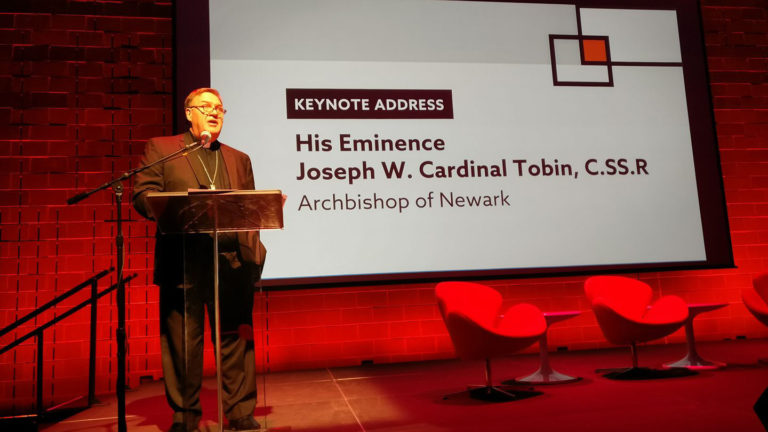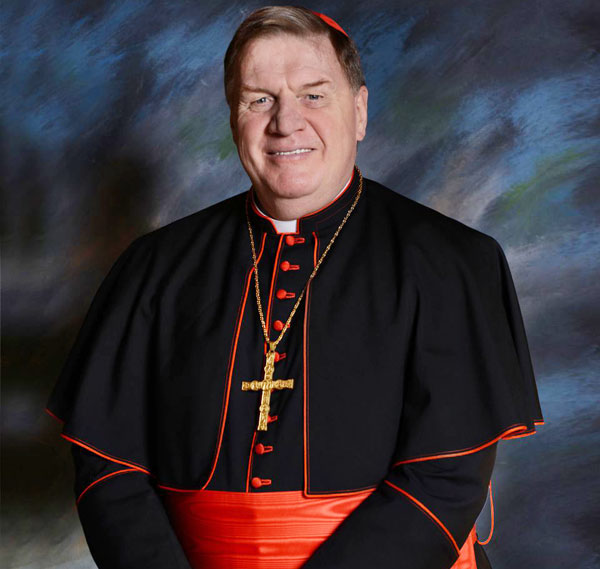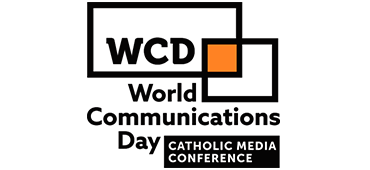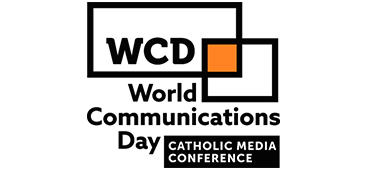On May 17 in Brooklyn, Cardinal Joseph Tobin applied Pope Francis’ World Communications Day message of “communicating hope and trust in our time” to the plight of immigrants in the United States today.
“Congress and the president could pass comprehensive immigration reform tomorrow if they wanted to,” Tobin said. “They could bring 12 million people out of the shadows if they wanted to.”
Cardinal Tobin, the archbishop of Newark, NJ, made headlines in March when he accompanied Catalino Guerrero, a 59-year-old grandfather, to a deportation hearing. On Wednesday, in his keynote speech at the DeSales Media Group’s annual Catholic Media Conference, he talked about the message he was trying to convey by standing beside Guerrero.
“First, it put a face on people who are frequently dehumanized,” he said, referring to immigrants. “Secondly, it put a face on us and the call to solidarity.”
Accompanying Guerrero, he said, was a “symbol that communicated hope that the Church does not live in some ivory tower, that our faith has not been privatized, that the Church, the body of Christ, has a right to a voice in the public square.”
Without the solidarity of the brothers and sisters from a variety of faiths who stood up for Guerrero, Tobin said, he might have been taken away.
Tobin was critical of the news media, saying that they needed to resist engendering fear as a way of driving ratings and profits, but he saved his harshest criticism for the Trump administration.
“Congress and the president could pass comprehensive immigration reform tomorrow if they wanted to,” Tobin said. “They could bring 12 million people out of the shadows if they wanted to.”
He continued: “A person unbound by Christian charity would say that you really have to believe in inflicting cruelty on innocent people to choose to support the policies [on immigration] we’ve seen in recent months while possessing the power to change the law.”
Cardinal Tobin, who also received the St. Francis DeSales Distinguished Communicator Award from Bishop Nicholas DiMarzio of Brooklyn, delivered his speech on a day dedicated to examining communication and the media from a Catholic perspective.
Before his keynote, four national television reporters — Howard Kurtz, Ray Suarez, Lauren Ashburn and Antonio Mora — participated in a discussion of the state of their industry entitled “Fact or Fiction: Journalism’s Last Stand?”
From left, Howard Kurtz, Antonio Mora, Lauren Ashburn and Ray Suarez in Wednesday’s media panel.
In a wide-ranging discussion, the panelists talked about the political polarization of the American public; the blurring of lines between news, opinion and entertainment; the obligations of the media and their audience; the lack of public confidence in the media; and what to do when opposite sides of the political spectrum can’t even seem to agree on the facts.
Early in the discussion, Suarez posed this question to his colleagues: “How are we doing?”
“In a word, lousy,” Kurtz responded. “There’s a credibility crisis fueled in part by a lot of self-inflicted wounds.” He talked about news organizations’ allowing bias to creep into news coverage, about reporters’ motivation to stand out on social media with snark and personality, and about an unwillingness for news organizations to own up to their mistakes.
While the journalists on the panel were certainly self-critical, they also pointed out that some of the change in discourse was due to their audience. Mora said research has shown that the American news consumer is not that interested in international news, not that interested in serious local news, not that interested in civil discourse.
Social media was seen by the panelists as both part of the problem and part of the solution. Everyone can have a voice, Kurtz said, but that can make it hard for news consumers to assess credibility.
Ashburn said it was the media’s responsibility to deliver facts and balanced perspective, and the audience’s responsibility to seek the truth. Social media is one way they can find it, she said, pointing out the Pope’s millions of Twitter followers.
“I challenge the audience to find new ways of understanding and interpreting the news,” she said, “and they’re out there.”
The afternoon was dedicated to a screening of “Sacred,” a documentary that captures milestones of spiritual life across religions and around the world, and a panel discussion with the filmmakers, Thomas Lennon, Dr. William Baker, and Julie Anderson. Tim Glemkowski, a national Catholic speaker and evangelist, moderated the discussion. He also delivered the day’s opening talk and served as emcee.
The day began with an introduction by Rev. Monsignor Kieran Harrington, the Vicar for Communications for the Diocese of Brooklyn, and an original song, “Fear Not,” performed by Christian hip-hop artist Kei-Landa. (You can download it here.)










